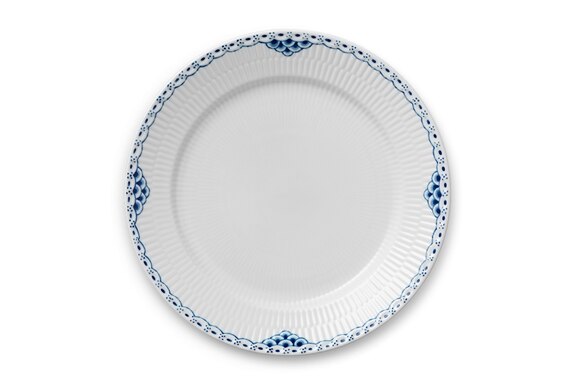Thank you!
We hope you will enjoy your membership of the Royal Copenhagen Collector's Club.
Blue palmettes, elegant laces, countless brush strokes and white flutes are just some of the characteristics of Royal Copenhagen's collections. Get an chronological overview of the collections we have in store today below.

The story of Royal Copenhagen began with Blue Fluted Plain in 1775. For almost 250 years, the pattern has shown its timelessness, endurance, and vitality and inspired exploration and reinterpretation. As the first ever Royal Copenhagen pattern, Blue Fluted Plain is still to this day loved and appreciated all over the world. A true classic.

The Flora Danica collection is named after the botanical encyclopaedia of the same name, created in 1761. The famed dinner service is painted with naturalistic decorations of Danish plants exactly as they were depicted in the literary work, and the edges are decorated with 24 carat gold.

Roughly 100 years after the creation of Blue Fluted Plain and Blue Fluted Full Lace, artistic director Arnold Krog created Blue Fluted Half Lace. The collection continues the beautiful lace trim but without the perforated edge.

The shape of the Blue Fluted Half Lace collection was deemed beautiful even without the cobalt blue decorations. The delicate lace border and subtle flutes acted as decorations on their own and so the porcelain was introduced as White Fluted Half Lace as well.

When creative director Arnold Krog joined the Royal Danish Porcelain Factory in 1885, he instantly fell in love with an old open work border dessert plate from the factory’s earliest days. Originally this type of porcelain was only created as dessert service, but with this plate as his inspiration, he created the beautifully ornate Blue Fluted Full Lace collection as we know it today.

The White Fluted Full Lace collection features the same beautiful details as Blue Fluted Full Lace in the sculpting and shaping of the pieces. The open work lace border is carved by hand and ornate finishes such as snail shells and baroque masks adorn the lids and handles.

90 years after the launch of Blue Fluted Half Lace, the Princess collection is released. Once again the elegant lace trim is the inspiration. With its otherwise simple, white expression the collection beautifully contrasts the Pattern No. 1 collections.

Design student Karen Kjældgård-Larsen has reinterpreted the classic Pattern No. 1 and enlarged selected elements of the florals. The elegant but impactful decorations reveals a new expression to the classic Royal Copenhagen design.

Based on the shape of Blue Fluted Plain from 1775 the White Fluted collection is a beautiful choice for minimalists or those who wish to combine their blue painted pieces with a touch of fresh, crisp white elegance.

On the Blue Palmette dinnerware, fragments from Blue Fluted Plain unfold in a linear fashion on the pieces which provides a nice balance between classic and contemporary design.

The shape of the charming Christmas collection originates from a star fluted collection from 1783. The festive decorations and elegant gold rim were added to create the perfect dinnerware for one of the most tradition-filled times of the year.

Multicoloured Elements is edgy in more ways than one. A rainbow of colours emerges as textures transform across the crystal white landscape of a plate, sprawls around the delicately edged rim of a bowl, and playfully appears and hides as you turn a cup in your hand.

White Elements carry the legacy of Royal Copenhagen in its DNA. Featuring the original flutes of Blue Fluted Plain, the border of Blue Fluted Half Lace, and the rimmed edges of the legendary Flora Danica, White Elements brings an entirely new dimension to white dinnerware.

In Blue Elements, the well-known floral patterns of Royal Copenhagen are left to grow wild, whispering a centuries-old-story in a contemporary setting. The classic cobalt blue hue brings the element of history and traditionalism to this modern take on a classic.

As a contemporary salute to the iconic Flora Danica dinnerware, designer Anja Vang Kragh has created the beautiful Flora collection. Each piece is decorated with its own charming flower and an elegant gold rim.

blomst is a bold re-interpretation of Royal Copenhagen’s Pattern No. 2; Blue Flower. Dutch artist Wouter Dolk is the creative mind behind the characteristic collection where each piece is hand-painted with a single flower. The angular shape is inspired by one of the original Blue Flower collections.

This beautiful collection is deeply anchored in Royal Copenhagen’s history, while it also reaches for the future. The design-trio KiBiSi has created a multifunctional collection with loving nods to the Seagull Dinnerware as well as Royal Copenhagen’s nautical heritage; The three waves that are painted onto every piece of Royal Copenhagen porcelain.

In celebration of the 20th anniversary of Blue Fluted Mega in 2020, the Limited Edition-collection Mega Rose, created by Karen Kjælgård-Larsen and Mette Hannemann, is a gentle tribute to a new classic. Mega Rose interprets the well-known pattern of Blue Fluted Mega with airbrushed hues and blooming roses.

The iconic fluted design of Royal Copenhagen is emphasized in Blueline by the smooth stamp that carefully interrupts the fluted surface. Each piece is hand-painted with a thin blue line on the rim; a technique that requires a steady hand from this skilled painters.

Once again the classic Blue Fluted Half Lace design acts as inspiration for a new Royal Copenhagen collection. Design duo GamFratesi has combined elements of the decorations from the historic half lace dinnerware in new ways and thus created a new vibrant expression brought to life through motifs of animals from the coast and deep and shallow seas.